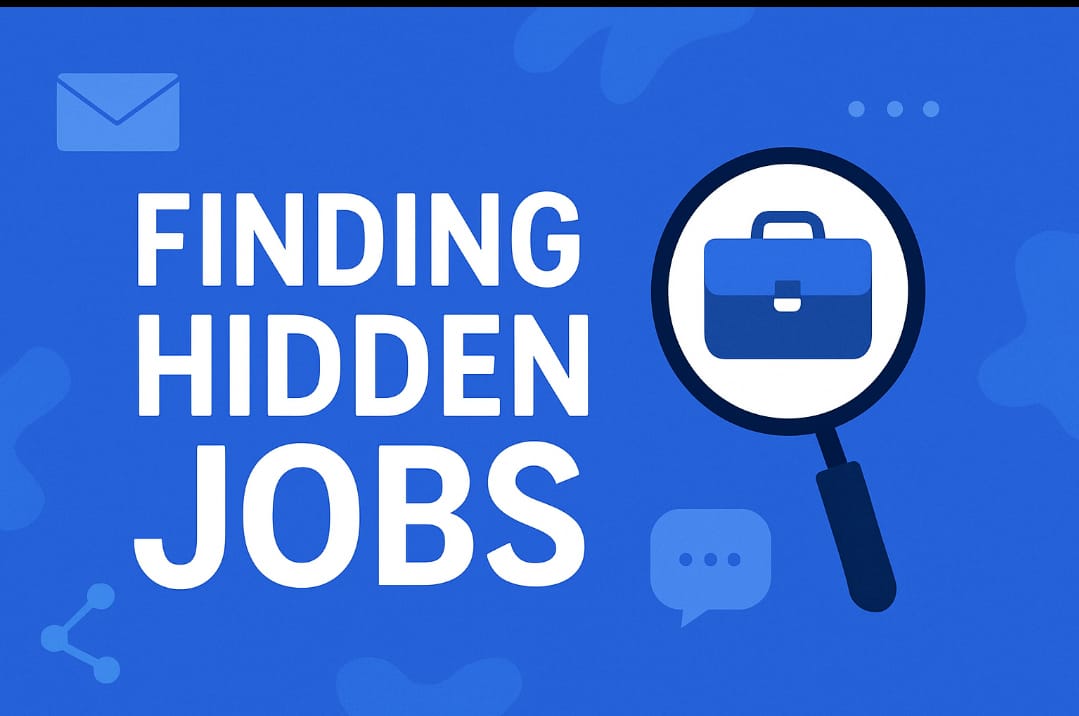What is the Hidden Job Market?
Hidden job market means the opportunities which does not post publicly on any websites or portals such as LinkedIn. People get to know about these jobs, when they talk to any employee of the company, if someone has refer., or if anyone has talked directly with HR. Many companies hire candidates internally through their network., without posting officially. That’s why it is important to start networking, do cold emailing, and stay active on LinkedIn to know about these hidden jobs.
Why do Companies Not Advertise All Jobs Publicly?
Companies advertise all jobs publicly for several important reasons. Firstly, it ensures legal compliance and promotes fair hiring practices by giving equal opportunities to all candidates, regardless of background. Public job postings also help companies reach a wider talent pool, increasing their chances of finding the best-fit candidate. Additionally, it strengthens the company’s employer brand by showing that they are open, inclusive, and growing. Even when internal candidates or referrals are being considered, public listings maintain transparency and fairness in the hiring process, which helps build trust among current employees and upholds the company’s professional reputation.
How to Find Hidden Job (That Never Make It to Job Boards)?
1. Networking: Your Most Powerful Tool to Find Hidden Jobs
Networking is very important in job hunting because, with the help of networking, you can reach those hidden job that are sometimes unavailable on job portals. Many companies hire candidates internally or through referrals, which means that if you have a strong network, you will be aware of those jobs. You get real industry insight from networking, like which skills are in demand, what the company’s culture is, or what the expectations of a specific role are. When you interact with a professional, it also boosts your confidence and improves your communication skills. Which helps in your interview. Networking is not limited to jobs only – it can also be one way for your long-term career growth. If today you are having a small conversation with a professional person, no one knows, maybe the next day that person will be the reason for your big opportunity.
How to build genuine connections?
Networking could be overwhelming for a job seeker, but if you follow a step-by-step approach, then it will become easy and effective. First, you need to set your career goal, like – in which industry do you want a job, which role do you prefer, and which company is your priority. Then, accordingly, you have to use your network, like a school or college benchmate, a colleague, a teacher, or family friends.
The next step is to update your profile on a professional platform like LinkedIn. Then start connecting with people and start commenting on industry-related posts. You can also share someone’s valuable post on your profile to show your visibility. When you connect with someone, send a short and polite message to introduce yourself and your purpose to connect with them. The most important part of networking is follow-up. Maintaining connection is important, that’s why check regularly, engage with their updates, and express gratitude. Slowly you’ll see progress in your network.
What is the importance of information interviews?
Before asking for a hidden job directly to a professional, you should always start a valuable conversation, such as asking about their experience. Talking casually is called an information interview. It is a non-formal conversation where you gain knowledge by asking professionals about their career paths. The goal is not to ask for a hidden job, it is to gain knowledge and build connections.
But first, you need to know:
- Who Should You Reach Out To?
Approach a professional in the same field in which you also have an interest and want to work. - How to Send the Message?
Send a short and respectful message telling them that you also want to learn about their industry. - Example, – “Hi [Name], I’m exploring a career in [Field] and really admire your journey. Would you be open to a 15-minute call sometime this week to share your experience? I’d truly appreciate it.”
What to Ask in an Informational Interview?
- Here are a few great questions:
- How did you start your career in this field?
- What skills or qualifications helped you succeed?
- What’s the work culture like at your company?
- What advice would you give to someone just starting out?
Don’t Forget to Follow Up
After the call, don’t forget to reply to them with a sweet thank-you message.
Build a Long-Term Relationship
Stay in touch. Engage with their posts on LinkedIn, share relevant updates, and maintain the connection. You never know when a casual contact turns into a valuable opportunity.
Informational interviews help you access insider knowledge, grow your confidence, and expand your network — all without asking for a hidden job directly. It’s a smart, respectful, and highly effective strategy.
2. Cold Outreach: Contacting Companies Directly for Hidden Job
You can also find hidden jobs by contacting them directly; style and tone are also important. When you approach any professional through LinkedIn or email, first give your short interview – who are you, what is your occupation, and what is the purpose of connecting. Keep the message short, polite, and personalized.
Example
“Hi [Name], I came across your profile while exploring opportunities in [industry/role]. I’m currently looking to grow in this field and would love to learn from your experience. Would you be open to a quick chat sometime next week?”
This type of message shows your professionalism and your genuine interest. If you receive any message from them, don’t forget to reply to them with a thank you message. And if you don’t get any response, then send a polite follow-up after 2 to 3 days. Always start a value-based conversation, don’t approach just to ask for help. First, build a relationship then opportunity will come automatically.
How to identify companies you’re interested in?
To identify companies you’re genuinely interested in, start by reflecting on your career goals, preferred work culture, and industry. Research companies through LinkedIn, Glassdoor, and their official websites to understand their mission, values, work environment, and growth opportunities. Pay attention to news articles, employee reviews, and social media updates to gauge how they treat employees and their reputation in the market. Join industry-specific forums or events to discover popular or rising companies in your field. Make a list of companies whose work aligns with your skills and interests, and follow them for job updates and networking opportunities.
Crafting a personalized cold email/message.
Crafting a personalized cold email or message starts with researching the person or company you’re reaching out to. Begin your message with a friendly greeting and mention something specific about their work, recent achievement, or company values to show that you’ve done your homework. Clearly state who you are, what you’re looking for (e.g., job opportunity, advice, collaboration), and why you’re reaching out to them specifically. Keep your tone professional yet warm, and your message short and clear. End with a polite call to action like requesting a quick call or asking if they’re open to connecting. Always thank them for their time.
3. Use LinkedIn Like a Pro
Your LinkedIn profile is your digital first impression — it’s often the first place recruiters and potential employers check before contacting you. To make it effective, start with a professional profile picture and a clear, keyword-rich headline that reflects your role or target position (e.g., “Aspiring Digital Marketer | Content Creator | SEO Enthusiast”).
Write a strong summary (About section) that tells your career story — include your skills, achievements, and what kind of opportunities you’re seeking. Make sure to add detailed experience, even if it’s freelance work, internships, or college projects. Use bullet points to describe responsibilities and results clearly.
Also, don’t forget to:
- Customize your LinkedIn URL
- Add relevant skills
- Get endorsements and recommendations from colleagues or mentors
- Stay active by posting, commenting, and engaging with industry-related content
A well-crafted LinkedIn profile doesn’t just represent you — it works for you, 24/7.
4. Attend Industry Events to Search Hidden Job
If you are seriously looking for a job, then only applying online is not enough. Networking events like job fairs, industry meetups, webinars, seminars, or LinkedIn live sessions give you opportunities to meet real professionals. It is very helpful for your career.
Here are some practical tips that every job seeker must follow to gain maximum benefits from these events.
Research Before You Attend :
Find out who is attending – speakers, companies, and other professionals. Make a list of people or companies you want to connect with. Prepare a few questions or topics in advance.
Prepare Your Elevator Pitch
Have a 30-second self-introduction ready where you confidently say who you are, what you do, and what you’re looking for.
Example:
“Hi, I’m Priya, a freelance content writer focusing on lifestyle and motivation. I’m currently exploring full-time roles where I can use my skills to create engaging digital content.”
Dress Professionally
First impressions matter! Whether the event is in-person or online, dress neatly and professionally.
Be Confident but Respectful
Don’t hesitate to start a conversation. Ask about their work, share your interests, and try to find common ground. But avoid being pushy or asking for a job right away.
Collect Contacts and Follow Up
Exchange LinkedIn profiles or emails. After the event, send a short thank-you message and stay in touch with the people you met.
Attend Events Regularly
The more events you attend, the better you get at networking. Over time, you’ll build a strong professional circle.
5. Volunteer or Freelancer First
Freelancing platforms (such as Upwork, Fiverr, LinkedIn, or even referrals) allow you to do short-term projects. When you work for someone, you become a trusted contact who can refer you to someone or give you more work. You can gain experience, build a portfolio, and build long-term relationships through freelancing.
Volunteering and freelancing don’t just help you build your resume — they help you build a powerful, engaged professional network.
You’re seen as someone proactive and skilled, which makes a lasting impression on potential employers and collaborators.
How can project-based work help you connect?
Project-based work is one of the most practical ways to build meaningful professional connections. When you work on real assignments—whether freelance, volunteer, or internship—you collaborate with clients, managers, or teammates, which creates opportunities for genuine interaction. Instead of just introducing yourself online, your work speaks for you. People begin to trust your skills, see your work ethic, and are more likely to refer or recommend you in their network. It’s a natural way to stay connected, build credibility, and grow your professional circle—without the pressure of asking for a job directly.
6. Ask for Referrals
Referrals can increase your chances of getting hired faster. Don’t hesitate to reach out to people in your network — former colleagues, friends, mentors, or even LinkedIn connections — and politely ask if they can refer you for a role in their company. A referral not only boosts your credibility but also helps your application stand out in the sea of online applicants. Make sure to personalize your message and explain why you’re a good fit for the role. A simple, professional request can go a long way!
Tools that help you explore the hidden job
These tools help you find job leads, connect with decision-makers, and uncover unlisted opportunities:
1. LinkdIn
The first one is LinkedIn. It is a professional networking platform where people create their professional profiles to showcase their skills, experience, and achievements. This is the best platform for finding professional jobs.
2. Hunter.io
Great for finding professional email addresses of people you want to connect with (especially useful if they haven’t accepted your LinkedIn request). Helps you reach out via email with personalized messages.
3. Teal HQ
Helps you organize your job search with a smart tracker, resume builder, and job recommendations.
4. Wellfound
Many startup roles are shared privately or first announced here.
Reach out directly to founders or hiring teams even if the job isn’t listed.
5. Twitter / X
Founders and recruiters often tweet about roles before posting them officially.
Follow industry hashtags like #Hiring, #RemoteJobs, or #OpenToWork.
Conclusion
Networking isn’t just a job search “hack” — it’s a long-term career growth strategy. By building genuine connections, staying active on platforms like LinkedIn, and using the right tools, you can unlock hidden opportunities and get closer to your dream job. Start small, stay consistent, and let your network work for you.
If you want to start networking, and want to know more about it so read this “Networking strategies for job seekers”. It will help you to grow your career.
Explore hidden jobs with the help of Best Job Tool.







Leave a Reply